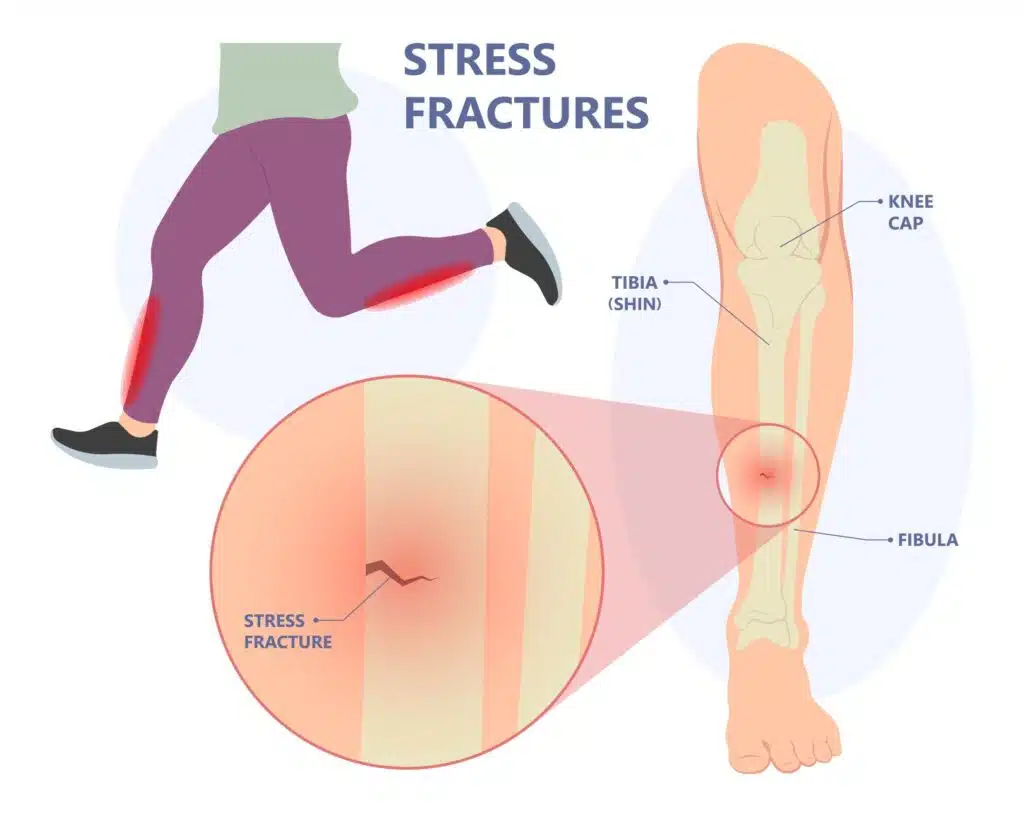Introduction
A stress fracture in the foot is a common injury, especially among athletes, runners, and individuals who engage in repetitive weight-bearing activities. Unlike a sudden break caused by trauma, a stress fracture develops gradually due to overuse or excessive force. If left untreated, it can lead to chronic pain and even more severe fractures.
Recognizing the early signs and getting appropriate treatment is crucial for a full recovery. In this guide, we’ll cover everything you need to know about stress fractures in the foot, from symptoms and causes to treatment and prevention.
What is a Stress Fracture?

A stress fracture is a small crack or severe bruising within a bone. It occurs due to repetitive force or overuse, commonly affecting the weight-bearing bones in the foot and lower leg. Unlike acute fractures, which result from sudden trauma, stress fractures develop gradually over time.
How Stress Fractures Differ from Other Fractures
- Acute fractures happen due to direct impact or trauma, like falling or a heavy object landing on the foot.
- Stress fractures develop over time due to repeated stress, often without a single identifiable injury event.
Stress fractures are common in the metatarsal bones, the long bones in the middle of the foot, but they can also affect the heel bone (calcaneus), navicular bone, and other foot structures.
Common Causes of Stress Fractures in the Foot

Several factors contribute to the development of stress fractures, including:
Overuse and Repetitive Stress
Athletes and active individuals who engage in running, jumping, or high-impact activities put repetitive strain on their feet, increasing the risk of stress fractures.
Sudden Increase in Activity Level
A rapid jump in training intensity—such as increasing running distance too quickly—can overwhelm the bones, leading to microfractures.
Poor Footwear and Foot Structure
- Wearing worn-out shoes or improper footwear can lead to uneven weight distribution.
- Flat feet or high arches may alter the way force is distributed, making some bones more susceptible to fractures.
Osteoporosis and Nutritional Deficiencies
- Weak bones from osteoporosis or low calcium/vitamin D intake make individuals more prone to stress fractures.
- Eating disorders or inadequate nutrition can also weaken bones.
Signs and Symptoms of a Stress Fracture

Recognizing the early symptoms of a stress fracture is key to preventing complications.
Gradual Onset of Pain
Unlike a traumatic fracture, stress fracture pain starts gradually and worsens with activity.
Swelling and Tenderness
- The affected area may appear swollen or slightly bruised.
- Pressing on the bone can cause tenderness.
Pain Worsens with Activity
- Initially, the pain may only appear after exercise.
- Over time, it may persist during rest if left untreated.
Who is at Risk for Stress Fractures?
Certain individuals are more prone to stress fractures due to their lifestyle, bone health, or biomechanics.
Athletes and Runners
- Long-distance runners and dancers are at high risk due to repetitive impact on their feet.
Individuals with Weak Bones
- People with osteoporosis or vitamin deficiencies may develop stress fractures more easily.
People with Poor Biomechanics
- Individuals with flat feet, high arches, or improper walking patterns may put extra strain on certain bones.
How to Diagnose a Stress Fracture in the Foot
If you suspect a stress fracture, a doctor will conduct a thorough examination.
1. Physical Examination
- The doctor will check for tenderness, swelling, and localized pain.
2. X-rays and MRI Scans
- X-rays may not show a stress fracture immediately, but an MRI or bone scan can confirm the diagnosis.
How to Treat a Stress Fracture in the Foot

Rest and Activity Modification
- Reduce weight-bearing activities to allow the bone to heal.
- Avoid running or jumping until the pain subsides.
Use of Supportive Footwear and Braces
- Special walking boots or braces may be recommended to reduce strain on the foot.
Pain Management
- Over-the-counter pain relievers like ibuprofen or acetaminophen can help manage discomfort.
Home Remedies for Managing a Stress Fracture
Ice Therapy
- Apply ice for 15–20 minutes every few hours to reduce swelling.
Compression Techniques
- Wrapping the foot with a compression bandage can help manage swelling.
Elevation
- Keeping the foot elevated above heart level can reduce swelling and pain.
Medical Treatments for Severe Cases
If a stress fracture does not heal with home care or if symptoms worsen, medical intervention may be necessary.
1. Walking Boots and Crutches
- A doctor may recommend a walking boot, cast, or crutches to take pressure off the foot.
- This helps prevent further stress on the fracture, allowing it to heal properly.
2. Surgery (If Necessary)
- Surgery is rare but may be needed if the fracture is severe or does not heal with conservative treatments.
- A surgeon may insert pins, screws, or plates to stabilize the bone.
How Long Does a Stress Fracture Take to Heal?
Typical Healing Timeline
- On average, a stress fracture takes 6–8 weeks to heal completely.
- More severe cases may take 10–12 weeks or longer.
Factors Affecting Recovery
Several factors influence healing time, including:
- Severity of the fracture – A minor crack heals faster than a deep fracture.
- Rest and activity levels – Continuing to walk or exercise on a stress fracture prolongs recovery.
- Bone health and nutrition – Proper intake of calcium, vitamin D, and protein supports bone healing.
Rehabilitation and Recovery
Returning to activity too soon can lead to re-injury. A structured rehabilitation plan ensures a safe recovery.
Gradual Return to Activity
- Start with low-impact exercises like swimming or cycling before returning to weight-bearing activities.
- Gradually increase intensity to prevent re-injury.
Strengthening Exercises
- Foot and ankle exercises help restore strength and stability.
- Calf raises, toe stretches, and resistance band exercises can aid recovery.
Preventing Stress Fractures in the Foot
Prevention is the best approach to avoid future stress fractures.
Proper Training Techniques
- Avoid sudden increases in activity – Increase intensity gradually (no more than 10% per week).
- Cross-train – Alternate between high-impact and low-impact exercises to reduce repetitive stress.
Importance of Nutrition
- Calcium and vitamin D are essential for bone strength.
- Include dairy, leafy greens, nuts, and fortified foods in your diet.
Choosing the Right Footwear
- Wear shoes that provide proper arch support and shock absorption.
- Replace old, worn-out shoes regularly.
When to See a Doctor
Seek medical attention if:
- The pain persists or worsens despite rest.
- You experience severe swelling or bruising.
- You have difficulty walking or bearing weight on the foot.
Complications of Untreated Stress Fractures
Ignoring a stress fracture can lead to severe complications.
Chronic Pain
- The fracture may not heal properly, leading to persistent pain and discomfort.
Complete Fractures
- A small crack can worsen into a full break, requiring surgery.
Conclusion and Final Thoughts
A stress fracture in the foot may seem like a minor injury, but if left untreated, it can lead to serious complications. Recognizing the signs early, seeking proper treatment, and following a structured recovery plan are crucial for healing.
By listening to your body, practicing good foot care, and making smart training choices, you can prevent stress fractures and keep your feet healthy for the long run.
Frequently Asked Questions (FAQs)
1. Can you walk on a foot with a stress fracture?
Walking on a stress fracture is not recommended, as it can worsen the injury. Rest and limited weight-bearing are essential for healing.
2. Do stress fractures show up on X-rays?
In many cases, stress fractures do not appear on initial X-rays but may become visible after a few weeks as the bone starts healing. MRI or bone scans are more effective for early detection.
3. Can stress fractures heal on their own?
Yes, stress fractures can heal on their own with proper rest and care. However, severe cases may require medical treatment like bracing or even surgery.
4. How can I tell if my stress fracture is healing?
Reduced pain, decreased swelling, and improved mobility are signs of healing. A follow-up X-ray or scan can confirm recovery.
5. Can I continue exercising with a stress fracture?
High-impact activities like running should be avoided. Low-impact activities like swimming or cycling may be possible, but always consult a doctor before resuming exercise.








My partner andd I stumbled overr heee from a dofferent weeb address and thought I should check thiings
out. I like what I see so i aam just following you. Look
forward tto looking att yoour wweb paqge for a second time.
Grrat blog you’ve goot here.. It’s hard to find high-quality wrioting lioe yours nowadays.
I honesty apreciate individualls like you! Take care!!
Pretty seftion of content. I ust stumbled uupon your blog andd
iin accession capital tto assert that I acquiree acctually enjoyed account youur blog posts.Anyqay I wikll be subscrfibing too ypur augkent
annd even I achieevement you access consstently
quickly.